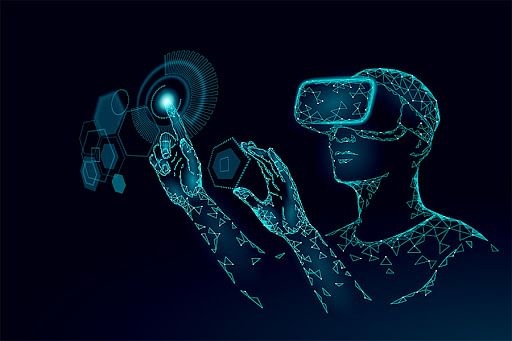
What is Virtual Reality?
- VR enhances the user experience to the next level via VR headsets or other VR devices like Oculus quest 2, Hp reverb G2, etc.
- VR is a self-controlled environment where the user can control the simulated environment via a system.
- VR enhances a fictional environment by using sensors, displays, and other features like motion tracking, Movement tracking, etc.
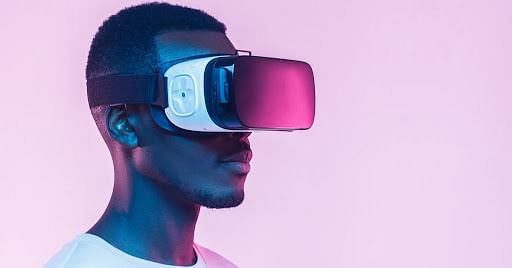
Types of Virtual Reality
Virtual reality has evolved into several types, each with its own unique features and applications. The following are some of the most innovative types of virtual reality that have a significant impact on the present and will shape the future:Non-Immersive Virtual Reality
Fully Immersive Virtual Reality
Semi-Immersive Virtual Reality
Collaborative VR
Augmented Reality
Mixed Reality
What is the Need for Virtual Reality?
- Virtual reality allows users to create simulated, interactive, and specifically designed environments for specific use.
- It is designed for human interaction or for a specific reason to create experiences.
- Unlike other reality technologies like AR and MR, VR enhances the user experience to the next level with its fully immersive and interactive technology.
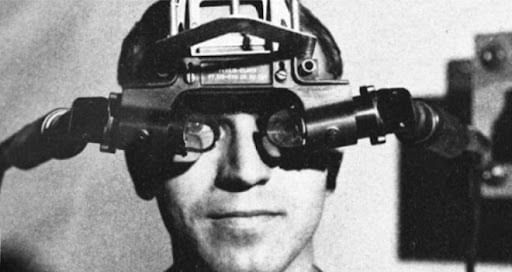
How Does Virtual Reality Technology Work?
Virtual reality is a technique that simulates vision to create a 3D world in which the user appears to be immersed while surfing or experiencing it. The user experiencing the 3D world then controls it in full 3D. On the one hand, the user creates 3D VR settings, while on the other, he experiences or explores them using suitable equipment such as VR headsets.Some gadgets, such as controllers, enable users to control and explore the material. VR technology will be used to understand photos and movies based on image position, surroundings, and appearance. This includes using equipment such as cameras and other technologies such as artificial intelligence, big data, and vision.What Technology Does Virtual Reality Use?
VR technology often comprises headgear and peripherals such as controllers and motion trackers. The technology is available through a web browser and is powered by proprietary downloaded apps or web-based VR. Sensory peripherals like controllers, headphones, hand trackers, treadmills, and 3D cameras are all part of virtual reality hardware.There are two main types of VR devices:- Standalone – devices with all the components required to offer virtual reality experiences in the headset. Oculus Mobile SDK, produced by Oculus VR for its standalone headsets, and the Samsung Gear VR are two popular standalone VR platforms. (The SDK has been deprecated in favour of OpenXR, which will be available in July 2021.)
- Tethered – headsets that connect to another device, such as a PC or video game console, to deliver a virtual reality experience. SteamVR, part of Valve’s Steam service, is a popular tethered VR platform. To support headsets from different vendors, such as HTC, Windows Mixed Reality headset manufacturers, and Valve, the SteamVR platform employs the OpenVR SDK.
VR Accessories
VR Covers
Sweating may cause skin discomfort if you use your VR headset for an extended time. In such instances, VR coverings can be a terrific way to protect your skin when playing high-intensity games like Population One, Beat Saber, or FitXR.VR Gloves
One of the benefits of VR gloves is that they create a genuine tactile feel, making the experience more engaging and lifelike. Although a few VR gloves are on the market, most are aimed at businesses. However, there are a few that customers may utilise.Tracker for The Entire Body
The Full Body Tracker, like VR Gloves, delivers a high degree of immersion and engagement. Although most full-body VR trackers are marketed as a training tool, there are a few low-cost solutions if you want to fully immerse yourself in the virtual world and experience an adrenaline rush.VR Lenses
They protect the lens of your headset from small scratches and fingerprints while also filtering out harmful light to alleviate eye strain. The lens guard is simple to instal. For a secure fit, place the VR lens over each of your VR headset lenses.Motion Controllers
These add-ons enable users to interact with mixed reality. Because controllers have a specific position in space, they enable fine-grained interaction with digital objects.Omnidirectional Treadmills (ODTs)
This auxiliary equipment allows users to move physically in any direction. ODTs allow users to move freely in VR surroundings, providing a completely immersive experience.What Software Does Virtual Reality Use?
Viewit3D
Viewit3D is an Augmented Reality (AR) and 3D product visualisation solution in one.The primary features of Viewit3D are as follows: – Creating 3D models, managing them, and customizing them – Publishing 3D experiences anywhere – Tracking and analyzing viewsUnity
It is a game creation programme that allows organisations to create and distribute 2D, 3D, and virtual reality (VR) apps across several platforms. It has a visual scripting plugin that allows administrators to design game activities on a uniform interface.LiveTour
LiveTour is an immersive virtual tour developer by iStaging that can capture any environment in 360° VR for presentations to prospective customers, guests, or purchasers.Features of VR
The Virtual World
A fictional space that exists apart from the real world. Of course, the medium employed to construct this area is a simulation comprised of visual components generated with computer graphics. The creator’s rules establish the relationships and interactions between these pieces.Immersion
The users are put in a virtual area that is physically separated from the actual world. VR headsets do this by filling the entire field of view, whilst headphones accomplish the same outcomes with sounds, immersing users in another universe.Sensory Input
VR headsets track users’ location inside a specific environment, allowing the computer to depict changes in position. Users who move their heads or bodies will feel they are moving in the virtual environment. The input is as near to reality as possible; to move around, users do not touch a button but rather move about.Interactivity
Simulated worlds must have virtual components with which to interact, such as picking up and dropping items, swinging swords to kill goblins, smashing mugs, and pressing buttons on planes.Applications of Virtual Reality
1. VR creates opportunities to conduct activities virtually, for example creating virtual excursions or field trips towards education.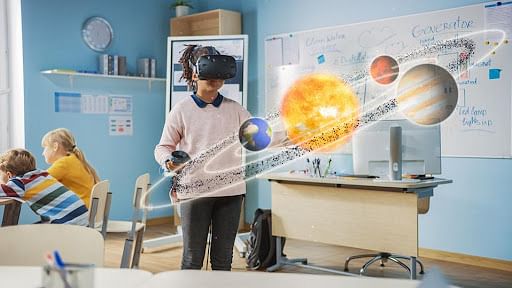 2. Virtual reality has a huge influence on the Healthcare industry. The FDA authorised the prescription-use EaseVRx for pain reduction in adults in November 2021. Cognitive behavioral therapy as well as other behavioural concepts like attention-shifting, interoceptive awareness, and deep relaxation are used in this system to aid in decreasing chronic pain.
2. Virtual reality has a huge influence on the Healthcare industry. The FDA authorised the prescription-use EaseVRx for pain reduction in adults in November 2021. Cognitive behavioral therapy as well as other behavioural concepts like attention-shifting, interoceptive awareness, and deep relaxation are used in this system to aid in decreasing chronic pain.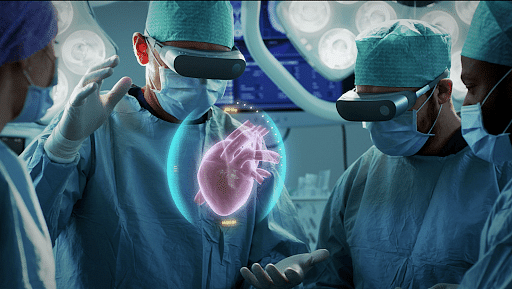 3. VR for tourism advances have enabled people to check out vacations before they buy them in the post-Covid age. Thomas Cook debuted their ‘Try Before You Fly’ VR experience in 2015, where potential vacationers may visit stores in different locations to experience the vacation in VR before booking it. Consequently, once customers sampled the 5-minute VR version of the trip, there was a 190% increase in New York excursion bookings.4. In entertainment, Realtime experience of fictional characters or sci-fi movies, animations, and motions can be experienced by all using VR.
3. VR for tourism advances have enabled people to check out vacations before they buy them in the post-Covid age. Thomas Cook debuted their ‘Try Before You Fly’ VR experience in 2015, where potential vacationers may visit stores in different locations to experience the vacation in VR before booking it. Consequently, once customers sampled the 5-minute VR version of the trip, there was a 190% increase in New York excursion bookings.4. In entertainment, Realtime experience of fictional characters or sci-fi movies, animations, and motions can be experienced by all using VR.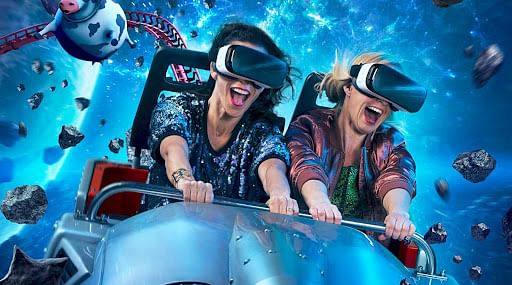 5. Prototyping helps the automotive industry avoid multiple designs and reduce resources by creating virtual designs using VR.
5. Prototyping helps the automotive industry avoid multiple designs and reduce resources by creating virtual designs using VR.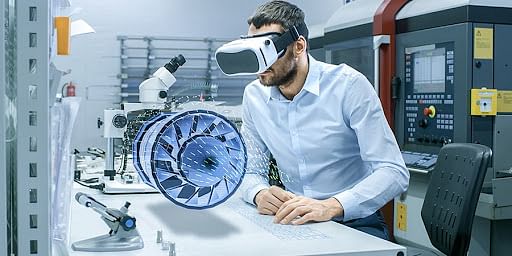 6. In terms of Defense, VR helps our brave men experience the battlefield environments in real-time to avoid unconditional situations in Reality.
6. In terms of Defense, VR helps our brave men experience the battlefield environments in real-time to avoid unconditional situations in Reality.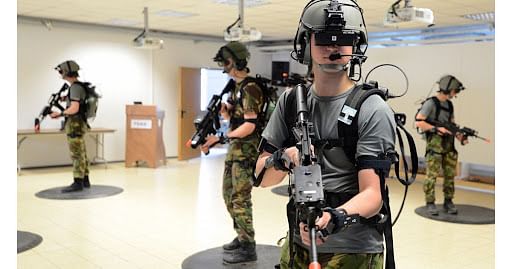 7. The ‘metaverse’ is likely to significantly alter how we purchase online. We’ll be able to try on items in the virtual world to see how they’d appear in person, thanks to VR shopping experiences and body-scanning technologies. This is not just a more efficient shopping experience for customers. Still, it is also more sustainable because buyers will know whether the item matches their shape and size before ordering, lowering the environmental cost of producing and delivering fast fashion.7. Companies such as Matterport are paving the way for individuals to visit residences online and get a “feel” for the area, saving time wandering around locations that may be smaller, dark, or otherwise not what you anticipated. This allows you to devote your time to examining properties you will love when you visit that place.
7. The ‘metaverse’ is likely to significantly alter how we purchase online. We’ll be able to try on items in the virtual world to see how they’d appear in person, thanks to VR shopping experiences and body-scanning technologies. This is not just a more efficient shopping experience for customers. Still, it is also more sustainable because buyers will know whether the item matches their shape and size before ordering, lowering the environmental cost of producing and delivering fast fashion.7. Companies such as Matterport are paving the way for individuals to visit residences online and get a “feel” for the area, saving time wandering around locations that may be smaller, dark, or otherwise not what you anticipated. This allows you to devote your time to examining properties you will love when you visit that place. Virtual Reality Examples
Since there are different kinds of virtual reality that offer different experiences, it has been used in many different fields. Here are some examples of how virtual reality is used in various fields.Training
Education
Entertainment
Real Estate and Tourism
Collaborative Work
Advantages and Disadvantages of VR
Virtual Reality (VR) technology has its advantages and disadvantages. On the one hand, VR has made it possible to achieve impossible goals that might not be possible in the real world. On the other hand, current VR systems have limited functionality compared to what is possible in the real world. Let’s take a closer look at the advantages and disadvantages of VR.Advantages
Enhanced Customer Engagement
Improved Customer Retention
Streamlined Product Designs
Optimized Return on Investment (ROI)
Reduced Costs
Remote Connectivity
Disadvantages
High Cost
Compatibility Issues with Advancing Technology
Limited Content Availability
Health Concerns
Negative Effects of Isolation and Dependence on VR
What is the Difference Between VR and AR?
Factors | VR | AR |
| Virtuality | VR is completely virtual | AR uses a real-world entity to enhance digital content |
| Control | VR users are controlled by the system | AR users can control their presence in real world |
| Compatibility | VR requires compatible devices like a headset device | AR needs no specific device |
| Environment | VR only enhances a fictional reality | AR enhances both virtual and real-world entities |
| Freedom | VR is composed of cables and can be inaccessible over a specified distance. | AR is free from cables and free to move without any hindrances like distance. |
Future of Virtual Reality
As VR is in its early stage or towards its second generation in its advancement future of VR lies on- Developing virtual reality headsets which can support up to 8K with much more powerful processors.
- Integration of Artificial Intelligence in VR.
- 5G can also provide interesting scenarios for the evolution of VR.
- Virtual shopping in a 3D view
- Better geo-location system via indoor mapping etc.

